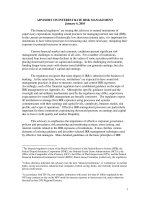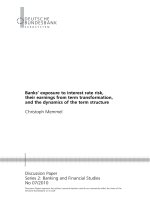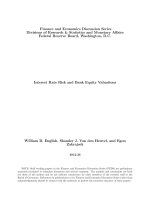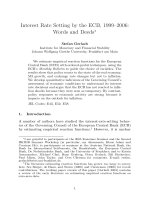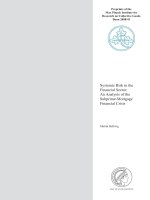INTEREST RATE RISK IN THE BANKING BOOK ppt
Bạn đang xem bản rút gọn của tài liệu. Xem và tải ngay bản đầy đủ của tài liệu tại đây (33.18 KB, 9 trang )
INTEREST RATE RISK IN THE BANKING BOOK
Over the past decade the Basel Committee on Banking Supervision (the Basel
Committee) has released a number of consultative documents discussing the
management and supervision of the interest rate risk inherent in a bank’s balance
sheet
1
. The Committee’s most recent release on this topic forms part of the proposed
New Basel Capital Accord (the New Accord), which comes into effect in 2007, and
details a capital adequacy framework for interest rate risk in the balance sheet as well
as a suggested supervisory methodology
2
. This article provides an outline of this
framework and discusses the implications for licensed banks, credit unions and
building societies [collectively referred to as Authorised Deposit Taking Institutions
(ADIs)] operating in Australia. The article describes some of the risk management
practices currently employed by Australian ADIs for managing this risk and considers
APRA’s plans for incorporating interest rate risk into the supervisory capital regime.
Introduction
Interest rate risk is the risk that an ADI will experience a deterioration in its financial
position as interest rates move over time. ADIs, and regulators, typically split interest
rate risk into two components: traded interest rate risk and non-traded interest rate
risk. (The latter is often referred to as interest rate risk on the balance sheet or in the
banking book.) Both refer to the potential impact of adverse interest rate market
movements; the difference lies in terms of where that impact occurs. Traded interest
rate risk is relevant to an ADI involved in trading activities and affects, for example,
the market value of that ADI’s positions in traded interest rate securities, such as
government bonds, and traded interest rate swaps. Interest rate risk in the banking
book arises from an ADI’s core banking activities. The main source of this type of
interest rate risk is repricing risk, which reflects the fact that an ADI’s assets and
liabilities are of different maturities and are priced off different interest rates. Also
recognised as a contributor to an ADI’s banking book interest rate risk exposure is
non-interest income, such as fee income, as it can also be highly sensitive to market
interest rates.
At present, APRA’s supervisory regime for ADIs requires that they hold capital
against the interest rate risk arising from taking trading positions in interest rate
markets (ie the interest rate risk inherent in an ADI’s ‘trading book’)
3
. ADIs are not
required to hold capital against interest rate risk in the banking book. This will
change going forward, however, as the New Accord provides APRA and other
national banking supervisors with the discretion to require capital to be held against
interest rate risk in the banking book
4
. The Basel Committee is of the view that
interest rate risk in an ADI’s balance sheet is a potentially significant risk and should
1
Refer to the 1993 and 1997 documents issued by the Basel Committee on Banking Supervision titled
“Measurement of Banks’ Exposure to Interest Rate Risk” and “Principles for the Management of
Interest Rate Risk” respectively.
2
Refer to the consultative document titled “The New Basel Capital Accord” and associated supporting
documents issued by the Basel Committee on Banking Supervision in January 2001.
3
Refer to APRA’s ADI Prudential Standard (APS) 113 Capital Adequacy: Market Risk, and associated
Guidance Notes.
4
Interest rate risk is only one area of risk addressed in the New Accord. The Accord also encompasses
significant changes to the current credit risk capital adequacy framework and proposes the introduction
of a capital requirement for operational risk.
2
be incorporated into the capital framework. However, given the heterogeneity among
international banks in terms of the nature of the underlying risk and the processes for
monitoring and measuring that risk, the Committee has determined that interest rate
risk in the banking book should be dealt with in Pillar Two of the New Accord
5
. This
means that each national supervisor will have discretion as to whether there is a need
to require all, or some, ADIs to hold capital against this type of risk. APRA intends to
exercise this discretion.
The proposed New Accord recognises ADIs’ internal systems as the principal tool for
monitoring risk. Where an ADI’s own internal systems are not appropriate, a
prescribed method for calculating this capital charge is proposed. Each method, own
or prescribed, will require an ADI to determine the potential decline in the net present
value of future cash flows (ie the ADI’s ‘economic value’ or ‘market value of equity’)
if its balance sheet was subjected to a one-off interest rate shock. This shock will take
the form of a yield curve shift based on either a specified parallel shift (eg 200 basis
points up and down) or a statistical approach using a specified confidence interval,
holding period and observation period. From these results, the supervisor can
determine whether the ADI should reduce its risk profile and/or hold additional
capital against the interest rate risk which it is running on the balance sheet.
Depending on the nature and scale of an ADI’s business, a wide variety of
methodologies could be employed in internal interest rate risk measurement systems.
These methodologies are outlined further below.
Principles for Interest Rate Risk Management
The New Accord sets out fifteen principles that are to be used by APRA and other
national supervisors to (i) evaluate the adequacy of an ADI’s approach to managing
interest rate risk, and (ii) assess the extent of interest rate risk being run by an ADI.
The principles set out the essential features of a sound framework for managing
interest rate risk, both in the trading and banking books, and are in line with any
robust risk management framework. Formalisation of these principles under the New
Accord will strengthen APRA’s existing qualitative approach to supervising interest
rate risk in the banking book. In broad terms, the principles address:
• the role of the Board and senior management in overseeing interest rate risk
management;
• the need for clearly defined risk management policies and procedures that capture
all sources of interest rate risk and ensure adequate segregation of duties;
• the importance of establishing and enforcing appropriate limits, of conducting
stress testing and of having adequate information systems for measuring,
monitoring, controlling and regularly reporting interest rate risk exposures; and
• the need for robust internal controls that are independently reviewed on a regular
basis.
The specific manner in which each ADI applies these principles depends on the
complexity of its activities as well as on the level of interest rate exposure. Risk
management practices within the Australian industry vary considerably. For the
smallest credit unions and building societies, most of whom run little if any traded
5
Refer ‘APRA’s Views on Basel II: Managing the Transition’ in APRA Insight Second Quarter 2002.
3
interest rate risk, senior management are actively involved in the day to day
management of risk and the degree of independence of the risk management function
is necessarily limited. For the regional banks, there is typically more separation
between those involved in the risk management, monitoring and control functions and
those involved in position taking. Within the major banks, management of traded and
non-traded interest rate risk is undertaken in two distinct units, with the latter typically
residing within the broader treasury function. In some banks, the traded and
non-traded interest rate risks are reported separately to Board level. In others, an
attempt is made to bring the two different forms of interest rate risk together. While
reporting of traded and non-traded interest rate risk may sometimes be aggregated,
ADIs’ overall risk appetites tend not to be aggregated owing to the different interest
rate outlooks that apply to trading and non-trading activities, with the latter typically
taking a much longer-term view.
Techniques for Measuring Interest Rate Risk in the Banking Book
Measurement techniques used to determine the potential impact of non-traded interest
rate risk on an ADI’s financial position can take a number of forms. The technique
used depends, in part, on whether the ADI focuses on earnings or economic value as
an indicator of its financial position. Clearly, interest rate moves will affect both
measures, often in very different ways.
Many ADIs choose to analyse the impact of interest rate moves on earnings, a
significant component of which is net interest income − the difference between
interest receipts and payments. Interest rate changes also affect interest-rate sensitive
non-interest earnings, such as loan servicing fees, although ADIs in Australia do not
tend to include such exposures when measuring interest rate risk exposure in terms of
earnings. Some ADIs also measure the affect of changing interest rates on the ADI’s
economic value or market value, that is, the cash flows that are expected to be
generated from the ADI’s on- and off-balance sheet positions, all discounted at that
interest rate which adequately reflects the riskiness of those cash flows.
In practice, the more sophisticated ADIs (the major banks and larger regional banks)
generally find some balance between techniques that focus on earnings and those that
focus on economic value. Economic value approaches offer a longer-term perspective
on interest rate risk, taking into account all future cash flows generated from an ADI’s
banking book positions. Earnings-based approaches, on the other hand, focus on short
run variability in net interest income, thus linking directly to reported profitability. In
the interest of reporting stable earnings streams, those ADIs that have adopted both
approaches tend to place stronger emphasis on measuring and managing net interest
income, typically focusing on future earnings one year ahead but sometimes
considering earnings out over the next two or three years. The longer the view,
however, the more difficult it becomes to accurately model these earnings streams.
A number of techniques are available for measuring the interest rate risk exposure on
the basis of earnings and economic value. As is the case with any risk measurement
approach, the methods used by Australian ADIs tend to align with the ADIs’ relative
levels of sophistication and the complexity or otherwise of the products offered. At
the simplest end of the spectrum are methods such as ‘gap analysis’, which rely on
4
repricing schedules to determine interest rate exposures.
6
At the other end of the
spectrum are detailed dynamic modelling techniques that incorporate, amongst other
things, assumptions about customer behaviour in response to changing interest rates.
The techniques also vary in terms of their ability to capture the different forms of
interest rate risk. The simplest techniques primarily only capture repricing risk. This
is the risk that the interest earned on assets and paid on liabilities will change by
different amounts if interest rates change owing to differences in the repricing
characteristics of those assets and liabilities. More sophisticated techniques are
typically able to incorporate a wider range of interest rate risk sources and can
therefore provide a better measure of interest rate risk exposure.
One such source of interest rate risk is ‘embedded optionality’, often a feature of retail
products. This feature gives customers the option to alter the cash flow of a product
in some way, often in response to changing interest rates, and thus impacting on the
amount of interest rate risk to which the ADI is exposed. For example, some fixed
rate mortgage products give borrowers the option to prepay the loan early without
penalty. For these mortgages, prepayments tend to increase as interest rates fall and
decrease as interest rates rise. The result is a divergence between the scheduled and
actual cash flows attached to the mortgage.
Another example of embedded optionality is an at call deposit, where customers have
the option of withdrawing the deposit funds at any time. The treatment of such
deposits is made all the more difficult by the fact that the interest rates received by
customers are administered by the ADI, being driven largely by competition and
internal cost factors. More sophisticated risk measurement approaches facilitate the
inclusion of assumptions about the timing and amount of future cash flows into the
interest rate measure.
Irrespective of the technique used, an ADI’s framework for measuring interest rate
risk exposure should encompass an evaluation of the impact on earnings or economic
value of stressed market conditions. This applies to both the banking book and the
trading book and is one of the Basel Committee on Banking Supervision’s fifteen
principles for management of interest rate risk.
In general, ADIs do not seem to have devoted as much attention to developing a stress
testing regime for the banking book as for trading portfolios. The reasons for this are
unclear but could include: model or systems limitations; the longer-term nature of
banking book interest rate risk exposure; or perhaps simply a lack of focus. In many
cases, the stress tests applied to the balance sheet are based on parallel movements in
the yield curve (ie interest rates at all maturities are assumed to move by the same
number of basis points). Such interest rate shifts are generally in the ±150 basis
points to ±200 basis points range but may be as much as ±300 basis points. These
shocks are commonly applied across the entire yield curve, although in some
instances the shifts are applied at either the long or short end of the curve only. No
more than a handful of banks have developed stress tests that go beyond these simple
shifts to incorporate changes in the shape of the yield curve, such as yield curve tilts
6
A repricing schedule reflects the repricing behaviour of an ADI’s assets, liabilities and off-balance
sheet positions. A balance sheet or off-balance sheet item is said to ‘reprice’ when the interest rate
applicable to that item is next scheduled to change.
5
(steepening/flattening), inversions and/or other ad hoc yield curve changes. The latter
stress tests are applied either as part of ADIs’ regular stress testing program or on an
‘as needed’ basis.
Repricing Analysis
As mentioned earlier, the simplest techniques used by ADIs to measure interest rate
risk exposures are based on repricing schedules or ‘gap reports’. Most Australian
ADIs produce a gap report, either for internal reporting purposes or, in the case of
credit unions and building societies, for regulatory reporting purposes. Although the
crudest approach to assessing interest rate risk, repricing reports have some intuitive
appeal and are typically widely understood. The gap report distributes individual
assets, liabilities and off-balance sheet positions into time bands based on either the
next repricing date if the product is based on a variable interest rate, or the maturity
date of the product if the product yields a fixed interest rate. Gap analysis is most
often a static analysis, which means it is based on an ADI’s balance sheet at a
particular point in time.
Gap analysis can be used to indicate the sensitivity of an ADI’s earnings and/or
economic value to a change in interest rates. Earnings-based approaches measure the
size of the gap in each time band, ie the difference between assets and liabilities
repricing in that time band, thus giving an indication of the ADI’s repricing risk
exposure. The direction of the gap indicates whether net interest income is positively
or negatively impacted by a change in interest rates and the magnitude of the gap
approximates the change in net interest income for any given interest rate shift.
A repricing schedule may also serve as the starting point for a simple economic value
based approach to interest rate risk measurement. The repricing schedule is used to
evaluate the effects of changing interest rates on an ADI’s economic value by
applying ‘sensitivity weights’ to the gap in each time band. These are based on the
duration of the assets and liabilities. Sensitivity or duration-weighted gaps are
multiplied by an assumed change in interest rates and then aggregated across time
bands to produce an estimate of the potential change in economic value of the ADI
given the assumed rate change. This approach forms the basis of the standardised
interest rate risk measurement methodology proposed by the Basel Committee. From
the visits that APRA has undertaken, it would appear that this approach is used by
only a very small number of ADIs. Of the few ADIs that have adopted an economic
value approach to interest rate risk measurement, the majority tend to use one of the
more sophisticated approaches outlined later in this article.
The means for determining the assumed interest rate change under gap analysis varies
across ADIs. Most of the smaller ADIs tend to use a flat one basis point or
one percentage point shift in interest rates across the yield curve. For these banks, the
gap report serves as an indication of exposures only, rather than as a quantification of
net interest income exposure against which capital should be held. The larger ADIs
that use gap analysis as a key reporting tool tend to base the change in interest rates on
6
historical rate volatilities, in much the same way as historically observed rates of
interest are applied to trading positions in a ‘value-at-risk’ framework
7
.
Despite its relative simplicity, gap analysis is common amongst ADIs, including
banks. For the majority of credit unions and building societies, it is the sole tool used
to manage and measure interest rate risk and this is reasonable in most cases given the
relative simplicity of these ADIs’ balance sheets. Some credit unions and building
societies, however, offer more complex products with embedded option features. One
such example is a line of credit facility attached to a home loan, which allows
customers to choose between either a fixed interest rate or the current variable rate for
drawings under this facility. For products such as this one, it is important for
appropriate risk management processes to be in place so that the ADI has a good
understanding of the potential future behaviour of these products.
For larger ADIs, the degree of reliance on gap analysis varies. There are some
regional and major banks, for example, that quantify interest rate risk using a gap
analysis and compare the results of that process against Board-approved limits. For
earnings-based approaches, limits are typically set over the first twelve months of the
repricing analysis. For approaches based on market value, limits tend to reflect the
longer term view of the analysis, being imposed on individual repricing buckets as
well as over the total cumulative interest rate risk exposure. A number of ADIs,
however, use gap analysis as only a secondary tool. For these ADIs, pricing and
hedging decisions tend to be based on more sophisticated interest rate risk
measurement techniques, with gap analysis used only to understand the overall
balance sheet structure and to identify unusual repricing ‘spikes’.
Simulation Approaches
A number of ADIs, particularly banks, use more sophisticated risk measurement
techniques than those based on simple repricing schedules. In one sense, these
approaches can be viewed as refinements of simple repricing analysis. However,
simulation approaches usually involve a more detailed breakdown of products such
that specific assumptions about product behaviour can be incorporated into the
analysis. These approaches also allow for more varied changes in the interest rate
environment, such as changes in the shape and slope of the yield curve, than does
repricing analysis.
Detailed assessments of the potential effects of interest rate changes on both earnings
(ie net interest income) and economic value can be made using simulations.
Moreover, simulations can be either static or dynamic simulation analysis. Static
simulations focus on the cash flows arising from the ADI’s current on- and
off-balance sheet positions for the term over which the change in net interest income
is to be measured. Dynamic simulations, on the other hand, encompass detailed
assumptions about the course of future interest rates and expected changes in the
ADI’s balance sheet, such as new business originations, product pricing assumptions,
prepayment forecasts and any run down in existing business.
7
See, for example, Reserve Bank of Australia publication RDP9708 “Measuring Traded Market Risk:
Value-at-Risk and back testing techniques” on the Reserve Bank of Australia’s website.
7
Under the earnings and economic value simulation approaches the use of third party
modelling software is very common. This is the case both within smaller ADIs that
do not have the skilled resources and/or the need to develop and maintain an in-house
model and within the vast bulk of larger ADIs. Although there are obvious benefits to
using a third party-developed system for measuring risk, it is imperative that the ADIs
using such systems understand the meaning and implications of the results produced
by the systems as well as the assumptions underpinning those results. APRA has
found this to be more of an issue for the smaller ADIs and regional banks than with
the major banks. A related issue is that of data integrity. ADIs of all sizes often pay
little attention to the quality of data input into the risk management model despite
those data being crucial to generating meaningful measures of risk. This is an area in
which ADIs need to devote more resources.
Net interest income and economic value simulations are almost always performed on
a monthly basis. Some of the factors ADIs consider when determining the simulation
frequency include the time between Asset and Liability Committee meetings, the
availability of balance sheet projections from the business units and the length of time
required to run the simulations and to perform reconciliations.
The net interest income approach to measuring and managing interest rate risk in the
banking book is by and large the primary focus of Australian ADIs. This approach
quantifies the potential change in net interest income using either a specified shift in
interest rates, eg a 200 basis point shift up or down, or a ‘simulated’ future path of
interest rates.
Within the broad class of net interest income approaches that exist, a range of
methods are used by ADIs to determine interest rate risk exposures. Smaller banks,
for example, tend to use a static net interest income simulation. In these cases,
interest rate risk is usually assessed as the potential change in net interest income over
the next twelve months, as a consequence of one or more relatively simple shifts or
tilts of the yield curve. These yield curve shifts are sometimes determined with
reference to the historical behaviour of interest rates. Little attempt has been made to
model changes in spreads between interest rates within this framework.
By contrast, the larger banks use a dynamic approach to determining potential
changes in net interest income, thereby incorporating expected changes in the balance
sheet into the analysis. ADIs often align projected business volumes with the broader
budgeting and/or planning processes in operation.
Although dynamic analysis is generally regarded as providing a more realistic
measure of changes in net interest income over the period being modelled, the
usefulness of a simulation-based interest rate risk measurement technique depends
heavily on the validity of the underlying assumptions. Hence, it is crucial that the
process for formulating the assumptions underpinning the approach is robust, credible
and transparent. Some of the larger banks require that changes to modelling
assumptions be approved at senior management level. A comparison of the
model-generated net interest income result with the actual net interest income result
for that period is also conducted by some banks as a reasonableness check on the
model. At other banks, there is often less emphasis on independent review, the
rationale being that the assumptions are often too complex to be understood by those
8
external to the risk modelling areas. This is another shortcoming that ADIs need to
correct.
ADIs using the dynamic approach also tend to incorporate more sophisticated models
for determining the future course of interest rates. One example is the use of a ‘Monte
Carlo’ simulation approach to generate several hundred paths for possible interest rate
movements. From these, the range of possible outcomes of changes in net interest
income is calculated. Most banks, however, use the implied market forward curve to
determine future interest rate scenarios.
There does not appear to be any consistency in the way that Board-approved net
interest income limits are expressed across ADIs. Some ADIs express limits as a
percentage of after-tax profit using either the previous year’s profit figure or expected
profit for the year ahead, whereas other banks set limits either as a percentage of
capital or as fixed dollar amounts. One ADI imposes risk thresholds, rather than hard
limits, on net interest income outcomes to indicate when the institution is running
medium and high levels of interest rate risk.
A small number of ADIs have implemented economic value simulation approaches to
interest rate risk measurement. These approaches express an ADI’s interest rate risk
exposure in terms of the potential change in the ADI’s economic value given a change
in interest rates.
In theory, the economic value approach is straightforward, requiring the economic
value of an ADI to be determined before and after an assumed change in interest rates,
in much the same way as a value-at risk approach is used to establish the potential
dollar amount at risk on a trading portfolio. This in turn requires all future cash flows
associated with an ADI’s assets, liabilities and off-balance sheet positions to be
discounted at relevant market rates of interest and then summed to determine an
overall net present value figure for the ADI. The calculation is then repeated for the
assumed changes in market interest rates and the difference determined to yield the
estimated interest rate risk exposure. In practice, the calculation is much more
complex owing to the difficulties identified earlier in forecasting future cash flows, as
well as problems incurred in establishing an appropriate interest rate at which to
discount those cash flows.
One example of the economic value approach involves a static calculation over all
banking book positions using the same value-at-risk (VaR) methodology as is used for
the traded market risk portfolio (using a 97.5 per cent confidence interval). The
historical observation period may range from 1 or 2 years to 5 years
8
and the interest
rate holding period typically seen is either 1 day or 10 days. Discretionary-priced
products are often excluded from the analysis on the assumption that the market value
of these products is relatively insensitive to market interest rate movements. For
banks using this approach, the extent of banking book interest rate risk exposure that
can be assumed in an economic value sense is governed by Board-approved limits
expressed either as a dollar change in market value or as a percentage of Tier 1
capital.
8
In some cases, a number of different historical observation periods are used and the interest rate risk
exposure is determined as the worst outcome.
9
The Way Forward
The Basel Committee intends to finalise the New Capital Accord in the fourth quarter
of 2003, allowing for implementation of the framework at year-end 2006. Australia
will be following this timetable.
Using the discretion allowed to national supervisors by the Basel Committee, APRA
intends to require those ADIs using sophisticated modelling techniques to calculate
regulatory capital for credit and operational risks to also hold capital against interest
rate risk in the banking book. For those ADIs that do not have in place an
(appropriate) internal model, the requirement to hold regulatory capital against
interest rate risk will be determined on a case-by-case basis. In the latter instances,
the capital held will be based on a risk measurement method to be prescribed by
APRA.
In order to establish an appropriate quantitative framework for those ADIs using
either an internal model or APRA’s prescribed approach for determining regulatory
capital, a quantitative impact study will be undertaken later in 2003 and APRA will be
inviting ADIs to participate in this exercise. In consultation with industry, APRA also
plans to develop a qualitative framework for managing interest rate risk in the banking
book. All ADIs will be expected to satisfy these qualitative criteria. Details of both
the qualitative and quantitative frameworks for interest rate risk will be released to
industry for comment, in conjunction with all other prudential standards, in early
2004.
In line with international regulators, at this stage APRA plans to accept only the
economic value approach to measuring interest rate risk in the banking book for the
purposes of calculating regulatory capital. This will be the case regardless of whether
the ADI is to use its own internal measurement approach or the prescribed
measurement framework to be developed by APRA. Notwithstanding this, ADIs will
generally be expected to use other measurement methods to supplement those
prescribed by APRA.
Correspondingly, a project is currently under way within APRA to develop a formal
ADI supervisory framework for interest rate risk in the banking book. The project
will necessitate consultation with industry throughout 2003 and 2004, including
involvement in the quantitative impact study referred to above. The key outputs of
the project will be a Prudential Standard and risk reporting framework, both of which
will encompass the overarching principles set down by the Basel Committee.


